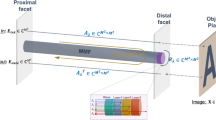Abstract
Traditional multi-mode fiber spectrometers rely on algorithms to reconstruct the transmission matrix of the fiber, facing the challenge that the same wavelength can lead to many totally de-correlated speckle patterns as the transfer matrix changes rapidly with environment fluctuations (typically temperature fluctuation). In this manuscript, we theoretically propose a multi-mode-fiber (MMF) based, artificial intelligence assisted spectrometer which is ultra-robust to temperature fluctuation. It has been demonstrated that the proposed spectrometer can reach a resolution of 0.1 pm and automatically reject the noise introduced by temperature fluctuation. The system is ultra-robust and with ultra-high spectral resolution which is beneficial for real life applications.
Similar content being viewed by others
References
KONG S, WIJNGAARDS D, WOLFFENBUTTEL R. Infrared micro-spectrometer based on a diffraction grating[J]. Sensors and actuators A: physical, 2001, 92(1–3): 88–95.
PÜGNER T, KNOBBE J, GRÜGER H. Near-infrared grating spectrometer for mobile phone applications[J]. Applied spectroscopy, 2016, 70(5): 734–745.
KRAFT M, KENDA A, FRANK A, et al. Single-detector micro-electro-mechanical scanning grating spectrometer[J]. Analytical and bioanalytical chemistry, 2006, 386(5): 1259–1266.
FARAJI-DANA M, ARBABI E, ARBABI A, et al. Compact folded metasurface spectrometer[J]. Nature communications, 2018, 9(1): 1–8.
MURRAY M J, REDDING B. Distributed multimode fiber Φ-OTDR sensor using a high-speed camera[J]. OSA continuum, 2021, 4(2): 579–588.
SAN FABIÁN N, SOCORRO-LERÁNOZ A B, DEL VILLAR I, et al. Multimode-coreless-multimode fiber-based sensors: theoretical and experimental study[J]. Journal of lightwave technology, 2019, 37(15): 3844–3850.
BRIENTIN A, LEDUC D, GAILLARD V, et al. Numerical and experimental study of a multimode optical fiber sensor based on Fresnel reflection at the fiber tip for refractive index measurement[J]. Optics & laser technology, 2021, 143: 107315.
SUN Y, LIU D, LU P, et al. High sensitivity optical fiber strain sensor using twisted multimode fiber based on SMS structure[J]. Optics communications, 2017, 405: 416–420.
FENG F, CHEN W, CHEN D, et al. In-situ ultrasensitive label-free DNA hybridization detection using optical fiber specklegram[J]. Sensors and actuators B: chemical, 2018, 272: 160–165.
CHEN W, FENG F, CHEN D, et al. Precision non-contact displacement sensor based on the near-field characteristics of fiber specklegrams[J]. Sensors and actuators A: physical, 2019, 296: 1–6.
MENG Z, LI J, YIN C, et al. Multimode fiber spectrometer with scalable bandwidth using space-division multiplexing[J]. AIP advances, 2019, 9(1): 015004.
REDDING B, POPOFF S M, CAO H. All-fiber spectrometer based on speckle pattern reconstruction[J]. Optics express, 2013, 21(5): 6584–6600.
REDDING B, CAO H. Using a multimode fiber as a high-resolution, low-loss spectrometer[J]. Optics letters, 2012, 37(16): 3384–3386.
REDDING B, ALAM M, SEIFERT M, et al. High-resolution and broadband all-fiber spectrometers[J]. Optica, 2014, 1(3): 175–180.
KÜRÜM U, WIECHA P R, FRENCH R, et al. Deep learning enabled real time speckle recognition and hyperspectral imaging using a multimode fiber array[J]. Optics express, 2019, 27(15): 20965–20979.
RAHMANI B, LOTERIE D, KONSTANTINOU G, et al. Multimode optical fiber transmission with a deep learning network[J]. Light: science & applications, 2018, 7(1): 1–11.
WANG P, DI J. Deep learning-based object classification through multimode fiber via a CNN-architecture SpeckleNet[J]. Applied optics, 2018, 57(28): 8258–8263.
MATJASEC Z, CAMPELJ S, DONLAGIC D. All-optical, thermo-optical path length modulation based on the vanadium-doped fibers[J]. Optics express, 2013, 21: 11794–11807.
HANSEN K, ALKESKJOLD T, BROENG J, et al. Thermo-optical effects in high-power ytterbium-doped fiber amplifiers[J]. Optics express, 2011, 19: 23965–23980.
TEZVERGIL A, LASSILA L V J, VALLITTU P K. The effect of fiber orientation on the thermal expansion coefficients of fiber-reinforced composites[J]. Dental materials, 2003, 19(6): 471–477.
PRADERE C, SAUDER C. Transverse and longitudinal coefficient of thermal expansion of carbon fibers at high temperatures (300-2500K)[J]. Carbon, 2008, 46(14): 1874–1884.
TAKAO Y, TAYA M. The effect of variable fiber aspect ratio on the stiffness and thermal expansion coefficients of a short fiber composite[J]. Journal of composite materials, 1987, 21(2): 140–156.
CHOI H-S, TAYLOR H F, LEE C E. High-performance fiber-optic temperature sensor using low-coherence interferometry[J]. Optics letters, 1997, 22(23): 1814–1816.
HE K, ZHANG X, REN S, et al. In deep residual learning for image recognition[C]//2016 IEEE Conference on Computer Vision and Pattern Recognition (CVPR), June 27–30, 2016, Las Vegas, Nevada. New York: IEEE, 2016: 770–778.
LI X, YU L, CHANG D, et al. Dual cross-entropy loss for small-sample fine-grained vehicle classification[J]. IEEE transactions on vehicular technology, 2019, 68(5): 4204–4212.
MAATEN L V D, HINTON G E. Visualizing data using t-SNE[J]. Journal of machine learning research, 2008, 9: 2579–2605.
Author information
Authors and Affiliations
Corresponding authors
Additional information
This work has been supported by the National Natural Science Foundation of China (Nos.91750205, U1701661, 61935013, 61975128, 61905147 and 61805165), the Leading Talents Program of Guangdong Province (No.00201505), the Natural Science Foundation of Guangdong Province (Nos.2016A030312010, 2019TQ05X750 and 2020A1515010598), the Science, Technology and Innovation Commission of Shenzhen Municipality (Nos.JCYJ20180507182035270, KQTD2017033011044403, ZDSYS201703031605029, KQTD20180412181324255 and JCYJ2017818144338999), and the Shenzhen University Starting Fund (No.2019073).
Rights and permissions
About this article
Cite this article
Gan, J., Shen, M., Xiao, X. et al. Deep learning enables temperature-robust spectrometer with high resolution. Optoelectron. Lett. 17, 705–709 (2021). https://doi.org/10.1007/s11801-021-1126-y
Received:
Revised:
Published:
Issue Date:
DOI: https://doi.org/10.1007/s11801-021-1126-y




